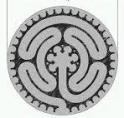Type in Style
For the typology of labyrinths I exclusively use one criterion: the course of the pathway. This becoms best apparent in the pattern. Labyrinths with the same pattern are thus of the same type. From this I distinguish the style. Style can be described as a trailblazing form of the graphical design.
Type and style complement each other. In many labyrinth examples it is possible to indicate the type and the style. However, it is not possible to indicate a style in every example. At the end I will attribute the labyrinth examples I used in this series to types and, if possible, indicate also the styles of them. A list of the types used is given at the end of this post.
From post Type or Style / 1
Cretan type in the Chartres style
Chartres type in the classical style
From post Type or Style / 3
Cretan type in the classical style
Cretan type in the concentric style
Chalice: There exist historical labyrinths with the same pattern. I therefore name this type Abingdon (not shown in post but mentioned)
Trinity: type of it’s own (type Trinity) in the Chartres style
St. Anthony: type of it’s own (type St. Anthony)
Circle of Peace: type of it’s own (type Circle of Peace)
Santa Rosa: type of it’s own (type Santa Rosa; not shown in post, but mentioned)
From post Type or Style / 4
Chartres 8 circuits: type of it’s own (type Regensburg; Cretan type with one additional trivial circuit at the inside)
Chartres 8 circuits: type of it’s own (type Charneu in the Chartres style).
Grey’s Court: type Grey’s Court
Ravenna 5 circuits: There exist historical labyrinths with the same pattern. I therefore name this type Compiègne
Chartres, 5 circuits: type of it’s own (type Emendingen)
From post Type or Style / 5
Type Reims
Type Chartres in the Reims style
In order not to overload this post I interrupt here and will present the other types in my next post.
The types:
- Type Abingdon
- Type Charneu
- Type Chartres
- Type Circle of Peace
- Type Compiègne
- Cretan Type
- Type Emendingen
- Type Grey’s Court
- Type Regensburg
- Type Reims
- Type St. Anthony
- Type Santa Rosa
- Type Trinity



























Pingback: Type or Style / 14 | blogmymaze
Thank you, Lea
for the information you have given about the Santa Rosa Labyrinth. Now it’s the turn of Andreas to incorporate this in the new system. I also have some new ideas, but I am not sure if Andreas may accept them as “true” labyrinths, the walk-through ones with two entries.
In any case we see the labyrinth offers new horizons and new insights.
LikeLike
Dear Erwin
Thank you for forwarding to me.
This is a nice abstract of the Santa Rosa labyrinth. But it has no importance for my typology. This is very straightforward and needs two informations: own pattern and first published. Therefore I did not use any further desriptions of any of the labyrinth types in my post. So for the purpose of a typology, nothing else has to be kept in mind or added to the system.
“Neo-medieval” designs, i.e. four-arm labyrinths with 7 circuits can be found manuscripts from Iceland of the 14th and 15th century already.
The so-called “heart space” is an element of the layout rather than the type and can be found in 16th century labyrinths from St. Omer or Gent already. So none of this is original in Santa Rosa. What is original is its course of the pathway. That makes it a type of its own.
I have strong doubts whether the other “neo-medievel” labyrinths were derived from Santa Rosa. I don’t know it for the St. Paul or the Petit Chartres labyrinths. But sure, the Circle of Peace was not derived from Santa Rosa but from the Abingdon type labyrinth.
Re. your new ideas: we had this already in our German blog. Currently I strictliy focus on unicursal labyrinths as defined by Kern. But I see no principal difficulty to extend the typology to other labyrinth alike figures. We would first have to create a new family or category for these kinds of figures and then proceed further.
LikeLike
Hello Erwin,
I just received the following post written by Andreas.
It is important to remember that the Santa Rosa Labyrinth was the first of the neo-medieval seven-circuit labyrinths that are now in circulation. The Circle of Peace, St. Paul, and Petit Chartres are actually derived from the Santa Rosa Labyrinth by moving one or two of the quarter or half turns. The Santa Rosa design was the inspiration for those designs. The Santa Rosa Labyrinth was also the first to bring attention to the heart-space, which has now been incorporated into many designs, regardless of number of circuits.
It is important that this history is remembered. Let me know if either of you have any questions.
I so appreciate all the work and knowledge that the two of you bring to the world of labyrinths.
Hope this finds you well.
My best,
Lea
Lea Goode-Harris, Ph.D. website & blog: http://www.labyrinthtales.com
>
LikeLiked by 1 person